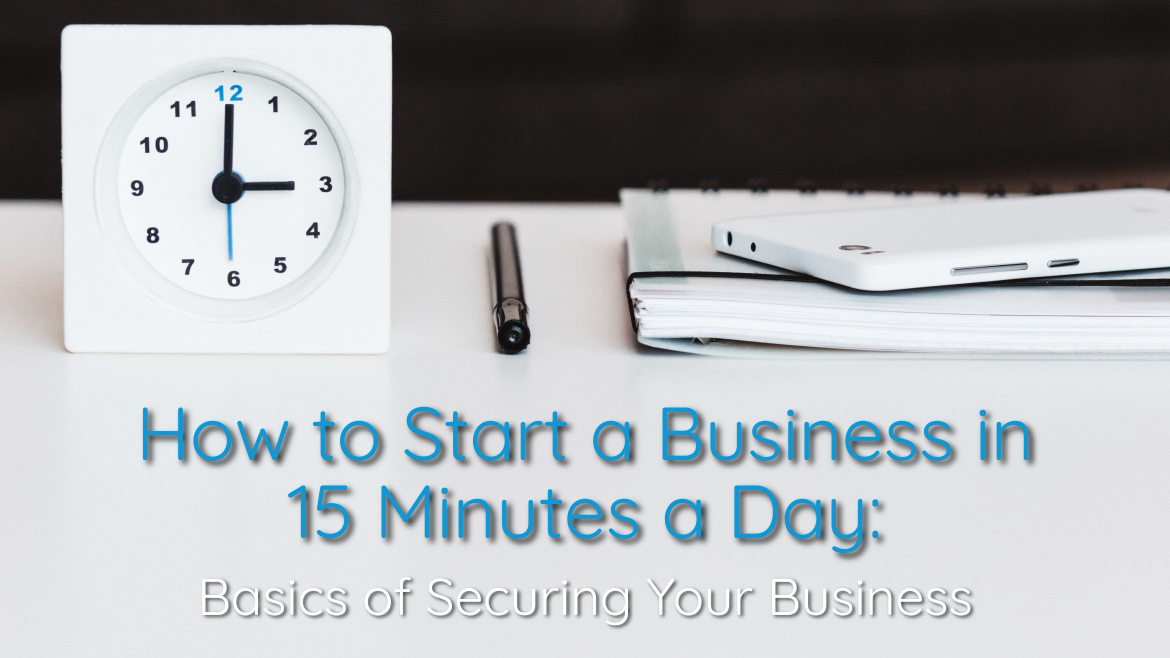Part 4 – Basics to Secure Your Business
This series aims to provide a formal plan to support new entrepreneurs seeking a process of launching a new business by breaking down the major components and first steps over a multi-part, day to day guide. Each part will highlight a major theme and provide daily, 15-minute activities for the upcoming month to help get you moving towards launching your new business! If you missed the posts, catch up on parts one, two and three.
In the sports world, specifically football, blocking and tackling are referred to as the basics or fundamentals. In the small business world, these basics or fundamentals are not easy or simple, but rather they are so important that you should ensure you view them as an ongoing and necessary aspect of running a business. Below we will review four distinct types of basics that are crucial to launching quickly once you have gotten ready to go!
LEGAL CONSIDERATIONS
There are numerous useful websites, articles and firms that can provide detailed assistance on the best types and forms of legal entities. Doing your research early and determining which type of legal entity is very important. What I see most often is that in Texas, most entrepreneurs – who are not high-tech startups seeking to raise venture capital – choose either a sole proprietorship at launch or an S corporation for its tax benefits. Regardless, understand your options by reviewing your goals as a business. If you are small, independent, and do not expect to do this business as much more than a side hustle, a sole proprietorship may be sufficient. For most small businesses however, filing a legal entity, like an S corporation, with the Texas Secretary of State’s Office is the best choice.
BANKING, CREDIT AND TRANSACTIONS
Once you have determined your preferred legal status and have begun the process of filing you will need to seek an Employer Identification Number through the Internal Revenue Service. This EIN will allow you to open up a corporate checking account and will be used for filing taxes and filling out W-9 forms in order to get paid by customers. After securing an EIN, you can use it to find a bank, create a W-9, setup payment processing through a site like Square, Paypal, or another online merchant, and other financial considerations.
WEB, SOCIAL & BRAND
Establishing a company name or brand is important and by this stage it should be firmly decided upon. You will need it to file for a legal entity, get your EIN and many more steps. Once you have decided on a name, you should secure web assets and social media handles. Use a website builder like weebly.com, wix.com, or others you see commercials about! These types of websites provide you the opportunity to use modules and prebuilt templates to create simple, but dynamic websites.
No website is complete without a nice logo and branding. There are numerous ways to create a brand and if you are not a creative type yourself, consider reaching out to a graphic designer or marketing firm that you know. Alternatively, sites like fiverr.com and freelancer.com allow you to quickly and cost-effectively get a logo created. Get inspiration for logo types, colors, and designs from brandsoftheworld.com.
Social media is more complex and requires both strategy and time. Consider starting out with one platform to develop your online presence. Selecting a platform is important and should be a tool that directly reaches your primary audience. Do your research, understand where your competitors are on social media, and learn from their behaviors. It is also important to use the platform you select on a regular basis. Try to post multiple times per week. Engage customers and partners professionally while strategically posting content that aligns with the best practices of others on that platform.
MARKETING AND AWARENESS
Creating awareness is no simple activity, but starting a marketing campaign is essential to getting the word out. First, make sure your website is functional, you have contact information and brand info visible, and that your social media platform is ready and active. Next, consider your customers and develop a multi-part campaign based on a key value proposition derived from your business model canvas or other feasibility work. Start with friends and family that are also potential customers by asking them to support your awareness campaign. Ask them to like, share, or comment on posts you make and to make introductions to others. Look for opportunities to put your concept in front of users, get their feedback, and make them ambassadors who share! Also, identifying local influencers who align with or complement your campaign. Engage them as partners and offer free products or promotion of them in return. While this is a first step into marketing, these efforts are an ongoing aspect of your business operations that should grow and become more creative as you move forward.
This concludes the fourth part in the series “How to Start a Business in 15 Minutes a Day.” Download the daily guide and structure to walk you through the recommended steps and actions for this month. Part 5 will be available right as you are completing this set of preparation so you can continue your journey to launch a new business!
Jeremy Vickers, Ph.D., serves as Associate Vice President of External Affairs at Baylor University where he leads institutional events, community relations, and external affairs. He is passionate about innovation and entrepreneurship and channels that passion to serve organizations where he can support both growth and change. Jeremy lives in Waco, TX with his wife Jackie and four children.


